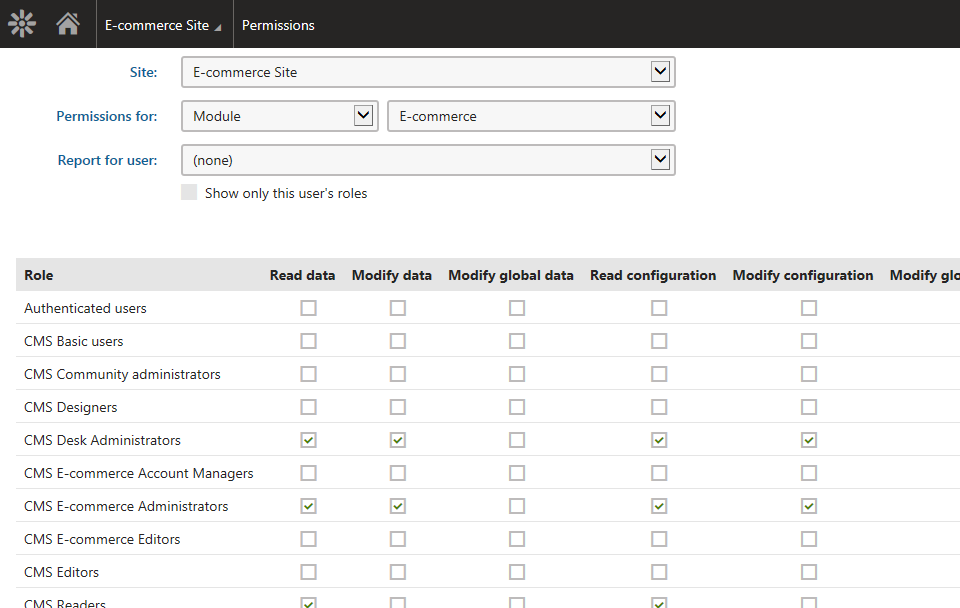Configuring permissions for store managers
To allow users to access and modify certain on-line store data but to prevent them from configuring the store, assign specific permissions to these users. You can:
- Assign specific permissions to every role to set what are specific users authorized to do.
- Assign specific users to be managers of a department.
Configuring e-commerce permissions for specific roles
Before you start editing permissions, assign users to roles. Then, to configure permissions of such users:
Open the Permissions application.
To filter the e-commerce permissions, select Module and E-commerce in the Permissions for field.

Select the desired permissions to a role:
- Read data – allows users to access orders, reports, customers, products, product options, product coupons, manufacturers and suppliers.
- Modify data – allows users to create, modify and delete data; see the Read data permission.
- Modify global data – allows users to create, modify and delete global customers, global products, global product options, global product coupons, global manufacturers and global suppliers.
- Read configuration – allows users to access E-commerce Solution configuration, i.e. your on-line store settings, departments, shipping options, payment methods, tax classes, currencies, exchange rates, order statuses, product statuses, invoices and discount rules.
- Modify configuration – allows users to modify E-commerce Solution configuration; see the Read configuration permission.
- Modify global configuration – allows users to modify E-commerce Solution global configuration.
- Read orders – allows users to access orders.
- Modify orders – allows users to create, modify and delete orders.
- Read reports – allows users to access reports.
- Read customers – allows users to access customers.
- Modify customers – allows users to create, modify and delete customers.
- Access all departments – allows users to access products from all departments.
- Read products – allows users to access products and product options.
- Modify products – allows users to create, modify and delete products and product options.
- Read discounts – allows users to access discounts and free shipping offers.
- Modify discounts – allows users to create, modify and delete discounts and free shipping offers.
- Read manufacturers – allows users to access manufacturers.
- Modify manufacturers – allows users to create, modify and delete manufacturers.
- Read suppliers – allows users to access suppliers.
- Modify suppliers – allows users to create, modify and delete suppliers.
- Destroy – allows users to destroy e-commerce object version history.
The system automatically saves the changes. The roles now have the permissions as you specified.
You can also edit permissions from the Permissions tab in the Roles application when modifying a specific role.
Example
To allow members of a selected role to edit site-specific manufacturers, you need to assign the role permissions in one of the following combinations:
- Read data + Modify data
- Read data + Modify manufacturers
- Read manufacturers + Modify data
- Read manufacturers + Modify manufacturers
Assigning product permissions
Permissions described on this page affect the E-commerce Solution objects only. If you need to restrict access to modifications of products, you need to distinguish between:
Products as SKUs + pages (default setting) – you need to select:
Corresponding e-commerce permissions
Page-related permissions
If the products are in a department, you also need to either name the user as a department manager or assign him theAccess all departmentspermission.
Example
To allow create, modify and delete products (with both SKUs and pages) completely, you need to select the following permissions:
From the E-commerce module:
Read products (or Read data)
Modify products (or Modify data)
Access all departments (or name the user as a store manager of the specific department) – required only if products are divided into departmentsFrom the Content module:
Browse tree
Read
Modify
Create
Delete
Products as stand-alone SKUs – the corresponding above-described permissions apply fully, i.e. you do not need any other permissions.
If the products are in a department, you also need to either name the user as a department manager or assign him theAccess all departmentspermission.
Example
To allow create, modify and delete products (only as stand-alone SKUs), you need to select the following permissions:
From the E-commerce module:
- Read products (or Read data)
- Modify products (or Modify data)
- Access all departments (or name the user as a store manager of the specific department) – required only if products are divided into departments
Creating department managers
When you set department managers, they can maintain only the products for which they are responsible. This prevents the department managers from accidentally modifying other products.
To allow a user, i.e. your department manager, to manage products in given departments, you need to:
Assign the roles whose member the given user is appropriate e-commerce permissions as mentioned above.
Assign the user to desired departments:
- Open the Users application.
- Edit () a specific user.
- Switch to the Departments tab.
- Click Add departments.
- Select the desired roles and click Select.
If you want to allow the user to manage products from all departments, assign the roles (whose member the user is) theAccess all departmentspermission.
The system automatically saves the changes. The specific user can now manage the departments you selected.
If you want store managers to be able to edit only a specific language version, see Allowing content editors to edit only specified language versions.